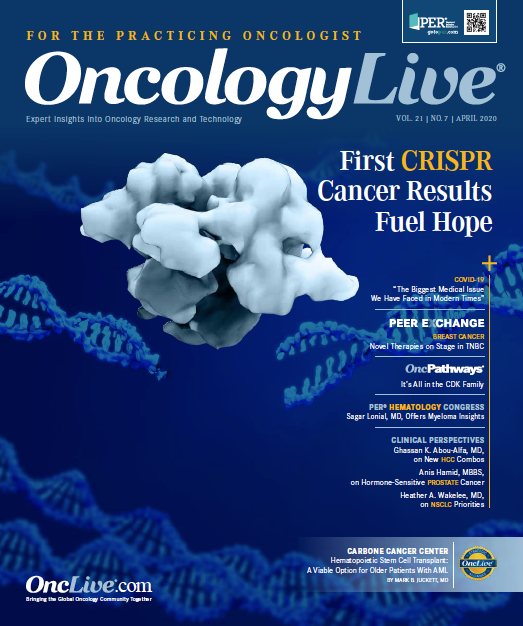Publication
Article
Oncology Live®
Isatuximab Affords the R/R Multiple Myeloma Setting a Tolerable New Alternative
Author(s):
Ken Shain, MD, PhD, discusses isatuximab-irfc and its potential to move into different stages of the multiple myeloma paradigm following further clinical investigation.
Ken Shain, MD, PhD

Ken Shain, MD, PhD
The recent approval of isatuximab-irfc (Sarclisa) combined with pomalidomide (Pomalyst) and dexamethasone offers adults with multiple myeloma whose disease has progressed after standard therapy a tolerable new treatment option.
On March 2, 2020, the FDA approved the triplet for adults with multiple myeloma who received ≥2 prior therapies including lenalidomide (Revlimid) and a proteasome inhibitor.1
The approval for the CD38-directed cytolytic antibody was based on efficacy results from the phase III ICARIA-MM (NCT02990338) trial, which showed that treatment with the triplet therapy conferred a significant survival benefit. The median progression-free survival (PFS) was 11.53 months with the regimen versus 6.47 months with pomalidomide and dexamethasone, translating to a greater than 40% reduction in the risk of disease progression or death (HR, 0.596; 95% CI, 0.44-0.81; P = .001).1
ICARIA-MM’s study population “represents a critical group of patients in multiple myeloma,” according to Ken Shain, MD, PhD, an assistant member of the departments of Malignant Hematology and Tumor Biology and the Chemical Biology and Molecular Medicine program at the Moffitt Cancer Center & Research Institute in Tampa, Florida. In an interview with OncLive, Shain discussed isatuximab-irfc and its potential to move into different stages of the multiple myeloma paradigm following further clinical investigation.
OncLive: Please provide an overview of the patient population.
Shain: In a disease like myeloma that we cannot control forever, we need to continue to develop new drugs and drug combinations to maintain control of the disease so that our patients can live their lives as long as possible. In this randomized phase III study, relapsed and refractory patients, defined by having received and failed 2 or more prior lines of therapy containing both lenalidomide and a proteasome inhibitor [PI], were enrolled. To this end, the study population represents a critical group of patients in multiple myeloma.
What is the agent’s mechanism of action?
Isatuximab is a monoclonal antibody that targets a protein called CD38 on the surface of multiple myeloma cells. Importantly, myeloma cells express this protein more than any other cell in the body, so it has become a very exciting target with an excellent therapeutic index in multiple myeloma. We have learned, both from isatuximab and from daratumumab [Darzalex], that targeting CD38 in myeloma is very effective in attacking myeloma cells.
Isatuximab targets and kills myeloma cells in a number of ways, including directly via apoptosis, which appears to be unique to isatuximab as a CD38-targeting agent, and indirectly through antibody-dependent cell-mediated cytotoxicity, complementdependent cytotoxicity, and antibody-dependent cellular phagocytosis. It may also function in an additional immunomodulatory capacity. Thus, isatuximab has a multifaceted way of helping us attack myeloma cells. This is likely why it works well in combination with other agents such as pomalidomide and dexamethasone.
What do we know about the agent’s tolerability?
Tolerability is always critical, and so to get to a phase III study, isatuximab has gone through phase I trials, in which we have identified a tolerable dose, as well as a phase II study where an effective dose was selected. In the context of ICARIA-MM, isatuximab is a very well-tolerated drug, with the exception of infusion reactions. Approximately 38% of individuals experience an infusion reaction. Importantly, infusion reactions are expected with this class of agents and are generally relatively minor.
We also know that isatuximab will have some potential toxicities when given in combination with drugs like pomalidomide and dexamethasone.
However, isatuximab is very well-tolerated therapy that did not add significant toxicities to pomalidomide and dexamethasone outside of infusion reactions. Regardless, it is critical for us to be mindful of toxicities and carefully monitor our individual patients because they may experience some additional toxicities.
How does the agent fit into the current treatment paradigm?
This is a question that we all will continue to strive to understand. We are always striving to improve our armamentarium; having more agents to control disease for longer periods is going to be important for our patients. I think isatuximab will initially be used primarily in later lines of therapy. Pomalidomide had been generally used in that setting but also has a critical role in combination with other CD38 antibodies earlier in therapy. That will create a space later in therapy to reuse this class of drugs in those 2 or 3 prior lines of therapy population.
What are the next steps for isatuximab-irfc?
Whenever we have a new agent approved, it allows us to start testing it with other drug combinations and in other disease settings. We will continue to ask questions and study its use in earlier relapse, maintenance therapy, and the newly diagnosed setting. Further, additional combination studies are being carried out and will continue to be carried out with other classes of drugs like PIs and selective nuclear export inhibitors. Answering these questions will provide our next steps.
Another really important part that we have not addressed is whether this agent can be effective in patients who have failed the same class of drugs. With its unique direct apoptotic activity on multiple myeloma cells, can we use this as a subsequent CD38- targeting agent after another monoclonal antibody has failed. Will it have activity in this subset? These are the studies we need to do so that we know whether isatuximab can be used to salvage patients or not.
It will be very important to see how we can move isatuximab and its exciting activity into our armamentarium. It has a shorter infusion than the previously approved CD38 antibody [daratumumab]. This may be one of the factors that will help it find its niche, perhaps among community oncologists who have busy schedules. To this end, isatuximab may be able to help patients get in and out of the clinics more efficiently. The triplet regimen provides an effective therapy that we can use to help our patients without adding untoward toxicity.
Sarclisa [prescribing information]. Bridgewater, NJ: Sanofi-Aventis US LLC; 2020. www.accessdata.fda. gov/drugsatfda_docs/label/2020/761113s000lbl.pdf. Accessed March 2, 2020.























%20(2)%201-Recovered-Recovered-Recovered-Recovered-Recovered-Recovered-Recovered-Recovered-Recovered-Recovered-Recovered-Recovered-Recovered-Recovered-Recovered-Recovered-Recovered.jpg?fit=crop&auto=format)
%20(2)%201-Recovered-Recovered-Recovered-Recovered-Recovered-Recovered-Recovered-Recovered-Recovered-Recovered-Recovered-Recovered-Recovered-Recovered-Recovered-Recovered-Recovered.jpg?fit=crop&auto=format)
